Although some marine fish will breed and grow quite readily in captivity, others are more problematic. One of the major difficulties in breeding these fish is the supply of suitable food for the larvae. In nature, many marine fish depend on copepods as their initial first food, but very few species of marine copepods have been successfully cultivated on a scale that is suitable for use in home aquaculture. Hopefully, this column will provide a basic background into copepod biology and life cycle, as well as provide a simple procedure for growing your own copepods. The procedures described below are taken from a basic understanding of the life requirements of the animal and a practical understanding of what a home hobbyist has access to. In my opinion, copepod cultivation may make an important contribution in home aquaculture, when fish fry are too diminutive to eat rotifers as a first food.
It is well known that for many species of fish fry live food is essential at the first critical stages of first feedings. In the oceans, potential food items most likely to be encountered by fish larvae are the nauplius stages of copepods. Copepods have probably been important in the diet of many fish during their evolution and effective predation strategies have evolved for capturing copepods as primary foods. Marine copepods are particularly suitable as food for fish fry. The size range (100uM nauplii to 1000uM adult) fit into the mouth of many larval fish. Copepod nauplii elicit a strong feeding response from many fish larvae, and Copepods have naturally higher levels of essentially fatty acids.
Currently the easiest way to supply copepods for home aquaculture is to capture them via netting in the wild; however, since our column focuses on home culture we will explain a simple how-to home culture copepods.
Copepods
Copepods are a class of animals within the larger group Crustacea. The group is diverse, with more than 10,000 different species in many different ecological niches. Copepods occur in most bodies of marine and freshwater. Many copepod species are parasitic, others swim freely as part of the plankton, while still others are benthic (bottom dwelling) or live on or around other organisms. Few free-living copepods exceed 2 mm in length as adults. Three major groups of free-living copepods have been identified: the Calanoida, primarily free swimming planktonic animals, The Cyclopoida, which may be planktonic or demersal, and the Harpacticoida, which are entirely benthic.
Copepods pass through very distinct life stages. They emerge from an egg as a nauplius, usually 100-150uM in length. After six nauplius stages (referred to as stages N1 to N6), with growth between each stage, the body shape changes and a series of usually six copepodid stages follow (referred to as stages C1 to C6). The last of these stages is the adult in which different sexes can be identified. Reproduction is sexual in nature, and in parts of the sea the nauplius larvae of calanoid copepods are the most abundant metazoan animals.
Life history and development
Fertilized eggs are held in a sac against the urosome of the female. When first released the eggs appear dark brown. As embryos develop the color and shade lightens until the mature embryos appear light brown with a dark eye spot just visible in each. Nauplius larvae emerge from the egg sac and swim freely. Newly released nauplii have up to four or five small lipid droplets regularly arranged in their body cavity. The first nauplius stage (N1) is very brief (a few hours) before the animals metamorphose to N2, then a rapid growth to N6. Following N6, the first copepodid stage (C1) occurs. By this stage the overall body form has changed from the ‘pear shape’ of the nauplius to the general form of the adult with conspicuous first antennae and a distinct division between the prosome and the urosome. As the animal develops through stages C1 to C6, the number of pairs of swimming legs increases from one to five and the total size increases. Between each developmental stage the animals shed the previous exoskeleton. By the stage C5 the geniculate antennae of males can just be detected, but by C6 (adult) this feature is conspicuous. The prosome length of females is slightly larger than that of males. When the final (C6 or adult) stage is reached, no further molting occurs. Development time is temperature dependent. At 25°C, embryo and nauplius stages are completed in 4 – 5 days and full maturity (embryo – adult) in a total of 10 – 12 days. Nauplii swim continually and are attracted to directional light. Copepodid stages are progressively less attracted to light and by stage C4 start to attach to substrates. Mature animals attach to substrates for lengths of time varying between seconds and minutes.
Habitat
Copepod populations are located in habitats where salinity ranges from almost fresh water to >35ppt. They can withstand temperature ranges from 10 – 28°C and water quality that is quite suspect.
As an example G. imparipes, as individual animals, can withstand salinity changes over a wide range. They can survive in temperatures from ~6°C to 28°C, and can tolerate periods without food. Adult copepods can store energy in large lipid reserves and persist without additional food. Embryos are protected by being carried until free-swimming nauplii are hatched and the survival rate of juveniles is increased by parental investment of food reserves in the embryo. This indicates that many copepod species are hardy enough to withstand the rigors of home cultivation.
Temperature
Although many copepods can survive through a wide temperature range (6 – 28°C), the best balance of animal health and culture production occurs between 20 – 25°C. At lower temperatures growth and egg production rates decrease, and at higher temperature water quality in the culture is difficult to maintain. Animals can be maintained within the recommended temperature range and then used at a higher temperature.
Movement
Many calanoid copepods possess two different modes of locomotion. A smooth, gliding, swimming motion is achieved by the force produced as the second antennae sweep at high frequency. This movement achieves both a feeding and swimming movement. The typical body orientation when swimming is with the body held at 45° to the horizontal.
More rapid movement through the water occurs as the animals ‘row’ with the five pairs of legs, resulting in brief moments of jerky movement through many body lengths.
Body size
Copepods at the first nauplius stage are 125µm long and 65µm wide. These grow to ~310µm long by N6. For copepodids and adults the length of the prosome is the most convenient descriptor of size. Adult G. imparipes have prosome lengths of 750µm – 950µm depending on the temperature at which they developed. As for other invertebrate animals, the growth rate is depressed at the low end of the tolerable temperature range, while the final body size of adults is larger for those grown in cooler than those grown in warmer water.
Nutritional content
All copepods are not of equal value to the diet of larval fish. Larval fish require a particularly long chain highly of unsaturated fatty acids (HUFAs) in their diet to ensure the normal development of their nervous system. These HUFAs are not synthesized by animals but are produced by phytoplanktons. Well- fed copepods are likely to have stores of these HUFAs and therefore to be beneficial in the diet of fish. Those copepods, which feed by scavenging on detritus or by predation on ciliates or rotifers, have a larger proportion of fatty acids in their stores have been synthesized from bacteria rather from phytoplanktons. These copepods are of lesser value in their diet to larval fish.
If copepods, which store high levels of lipids and carry embryos in a clutch have suitable phytoplanktons in their diet, their value as a food item for fish increases. A healthy population of these phytoplankton-enriched copepods will include adult females with fresh algal food in their gut, lipids in storage and eggs developing in their reproductive tracts. Studies have shown these enriched animals to be preferentially selected by feeding fish.
Feeding
Feeding appendages on the top part of the prosome are used for food collection. When the copepod feeds, the second antennae sweep backwards and forwards very rapidly to generate a current of water which flows through combs of fine setae on the first and second maxilla. These setaes remove potential food particles from the water. Food is then transferred to the mouth. In animals that have been actively feeding, the gut appears colored by the ingested food. When copepods have access to abundant food they produce feces at intervals of ~20 minutes. Fecal pellets can usually be seen in the lower gut of well-fed animals. Each pellet is contained within a membrane of chitin, which is released by the animal.
Copepod Culturing
There are many reasons to culture copepods and each of these reasons has its own set of requirements to gauge success. For purposes of this discussion, we will use the basis of culturing copepods to provide more diverse live food for a reef aquarium. It should also be understood that this is only one way to achieve the desired results and like most things in this hobby, there are many ways to achieve success.
Parts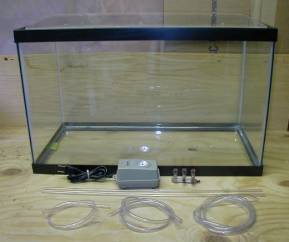
The first step, as in any project, is to assemble the parts we will need for the project.
- 1 – 10 gal tank
- 1 – Small air pump
- 1 – 2 gang air valve
- 1 – 36″ ¼” rigid tube (cut in two equal pieces)
- 1 – 12″ section of ¼” airline
- 1 – 24″ section of ¼” airline
- 1 – 36″ section of ¼” airline
- 1 – Acrylic lid with holes for rigid tube
Assembly
The next step is to assemble the parts.
- Connect the air pump to the gang valve with the 12″ section of ¼” airline.
- Connect each gang valve to the two remaining sections of airline.
- Connect a piece of rigid tubing to the ends of the two airline sections.
- Insert the rigid tubing in two of the holes in the acrylic lid. Place them at opposite ends of the tank. This will allow for better flow through the tank.
Select a source for phytoplankton to feed the Copepods
Phytoplankton can be found from many sources, including home culturing. Commercially available phytoplankton will tend to be more concentrated than home grown cultures. Pictured here are examples of DT’s Live Marine Phytoplankton, Reed Mariculture’s Plankton Live FeedDiet, and the typical 2-liter bottle of home grown phytoplankton. Which ever source you decide to use, make sure you use according to instructions to prevent contamination and spoilage.
Nannochlroposis is my preferred phytoplankton to feed copepods. Others may work as well or better, but Nannochlropsis is widely available from both commercial and home grown sources.
Once we have the phytoplankton, we need to fill the culture tank with an appropriate amount of phytoplankton. To prevent spillage and some of the mess, I typically fill the tank less than half full.
Now we have the culture tank filled and ready for copepods, not just yet. We need to make sure the culture tank parameters are within ranges.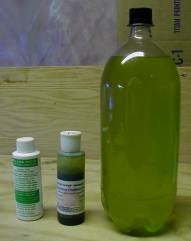
Temperature – For culturing copepods, I do not use a tank heater. I have had great success with room temperature. So what is room temperature? It means a room that is typically considered comfortable. This does not include the room with no insulation on the Northwest side of a house on the plains of North Dakota in January.
Salinity – It is best to match the culture tank to the tank to be fed. This helps eliminate the possibility of salinity shock for the copepods.
Airflow – With the culture tank filled with phytoplankton, we can set up the airflow. This does not need to be forceful, but does have to provide some circulation. I found that adjusting the airflow to a rate slow enough to count the bubbles to be adequate.
Lighting – Ambient room lighting or low wattage fluorescent lighting.
Adding the Copepods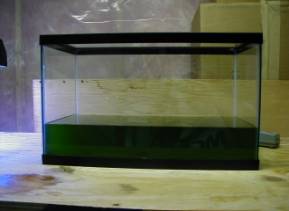
If we’ve successfully completed all the above, we can now add the copepods. When adding the copepods try to insure they are near the same water parameters as that of the culture tank. If not, try to “acclimate” them slowly, although they are quite hardy. Standard acclimation procedures will work fine.
Culturing
With the phytoplankton and copepods added to the tank and the airflow set up properly, we are now culturing copepods. Well, we got started. The idea is to keep a green tint to the water, the greener the better to cultivate copepods to feed the target tank. As the water clears in color, add more phytoplankton. Once we reach the desired density we can start feeding the target tank.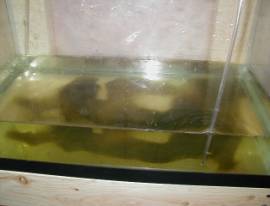
What density are we looking to achieve before we start feeding? This depends on the target tank. Once you start seeing copepods gathering on the tank glass, you probably have a good density.
These pictures show a copepod tank that has consumed the phytoplankton and the culture water has gone clear.
Having the culture water turn clear in color is not a ‘bad thing,’ but it is something we should try to avoid. If this does happen, we are left with two options:
- Add more phytoplankton to the culture tank to return the water to a green color.
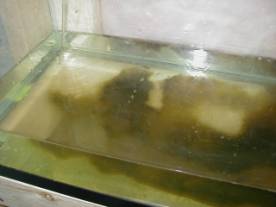
- Drain the tank through a strainer (53 micron works well), and then backwash the copepods into the culture tank with fresh phytoplankton. When draining the tank, I use a small diameter rigid tube to siphon out the water and copepods. When draining/siphoning the tank, try to minimize the amount of ‘gunk’ that is siphoned out.
The ‘gunk’ that builds up on the bottom of the tank is normal. Eventually, we will need to change the culture water and restart the culture. This can be done by following Option 2 above.
Feeding
Feeding methods vary from person to person. I will quickly describe the two methods I use to feed my tanks.
- Scoop out the desired feeding amount from the culture tank and pour it into the target tank. Replace the feeding amount taken from the culture tank with fresh phytoplankton. Because this is simple, it is my preferred method.
- The second method is to do the same as above except strain the copepods from the culture water and then backwash into the target tank. This reduces the amount of culture tank water added to the target tank.
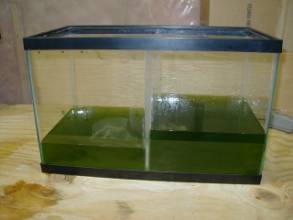
Cross-Culture-Contamination
I haven’t seen any ill effects from cross-contamination of cultures, with the exception of brine shrimp. It seems brine shrimp will eat almost anything and that includes copepods. It is possible to have a dual culture of copepods and rotifers.
Miscellaneous Notes
- Don’t worry if the water goes clear. I have had some copepods in a 2 liter bottle with no phytoplankton added for almost 3 months. They might have lasted longer, but I added some phytoplankton.
- Divide the 10 gal tank into two equal sections with a piece of plexiglass. This allows you to have two cultures of copepods and gives you some redundancy in case of a culture crash.
- Don’t be afraid to feed the target tank. I have deliberately fed large amounts of copepods to my main tank, and I have yet to see a negative impact.
- Try to change the culture tank water every 4 weeks on average or as water parameters warrant. This will help keep the quality of the culture water higher.
- When feeding from the culture tank, try not to scoop the bottom of the culture tank. If you scoop the bottom of the tank, you stir up a lot of waste that then potentially gets put into your target tank.
- Share your cultures with others and educate them on the ease of culturing live foods.


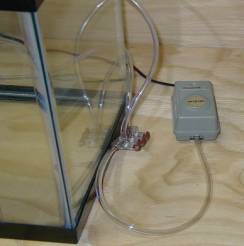

Hi,
I just started my copepods culture. I am having issue to know how much I have dose using phytoplankton. Normally by research it is based by the water turning green which means enough phyto in the water. I have 10 litter plastic food container and my salinity is 1.026 to match my tank . I put 250ml bottle of copepods into the culture container and dose according to the phytoplankton manufacture recommendations 5ml for 10 litter but after dosing the water is still clear. Is it not enough ?